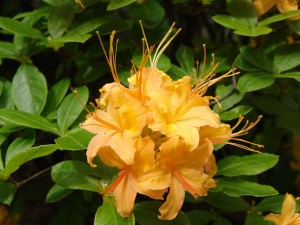Tip of the Week — 5/4/09
Posted in Gardening Tips, NYBG in the News on May 4 2009, by Sonia Uyterhoeven
Going Native: Azaleas for Everyone
 |
Sonia Uyterhoeven is Gardener for Public Education. Join her each weekend for home gardening demonstrations on a variety of topics in the Home Gardening Center. |
 Spring is a season of anticipation and joy. Cheerful bulbs emerge from the ground and cover the landscape with color. Flowering trees and shrubs follow suit in one of the year’s most magnificent displays. As the season unfolds, everything takes its turn providing a symphony of color—magnolias, flowering cherries, azaleas, redbuds, lilacs, and crabapples.
Spring is a season of anticipation and joy. Cheerful bulbs emerge from the ground and cover the landscape with color. Flowering trees and shrubs follow suit in one of the year’s most magnificent displays. As the season unfolds, everything takes its turn providing a symphony of color—magnolias, flowering cherries, azaleas, redbuds, lilacs, and crabapples.
One of my favorite players is the native azalea. It is a versatile plant that is often overlooked by the homeowner. Native azaleas are known for their spectacular bloom in spring. Many are incredibly fragrant, often with a spicy clove scent. A number of them also provide a wonderful show in the fall, with leaves ranging from yellow and burnt orange to fiery red.
Native azaleas have a graceful form that adds height and structure to any woodland garden. Most native azaleas grow from 5 to 8 feet tall, with some of them stretching to 10 feet at maturity. They rarely need any pruning, just an occasional thinning out of congested branches or removal of dead wood. Prune immediately after flowering.
To learn more about native azaleas…
Azaleas are members of the heath family (Ericaceae), which include mountain laurel (Kalmia), blueberries (Vaccinium), and Japanese andromeda (Pieris). These plants all have a fondness for acidic soils. Azaleas, like rhododendrons, have shallow roots that like to be kept cool and moist, with good drainage. Mulch plants with a 2-inch layer of organic mulch—shredded leaves, pine needles, or composted wood chips.
These plants are adaptable, tolerating full sun, part sun, or full shade. Flowering tends to be best in part sun/sun. There is an ongoing debate whether gardeners should deadhead their azaleas and rhododendrons. One of the reasons for deadheading is to increase flower productivity in the following year. This has been shown to be more relevant for larger evergreen rhododendrons that have a tendency to overextend themselves in one year and then recuperate the following year. Your native azalea will be a fairly easygoing, no-fuss companion in your garden.
My favorite feature of native azaleas is that you can have wonderful sequential blooms in a woodland garden from late April through July. The show kicks off with the coast azalea (Rhododendron atlanticum) and the pinxterbloom azalea (Rhododendron periclymenoides).
May heralds two fabulous native azaleas. The pinkshell azalea (Rhododendron vaseyi) starts the month off with a sea of white to pale pink blooms and the intensely fragrant rosebud azalea (Rhododendron prinophyllum) bookends the month.
While white- and pink-flowering azaleas monopolize the earlier season, the late season show is dominated by yellow-orange and red blooms. The fiery flame azalea (Rhododendron calendulaceum) is one of the showiest natives. It flowers from late May into June. It is followed by the more compact Cumberland azalea (Rhododendron bakeri). The season ends in mid to late July with the evergreen plum-leaf azalea (Rhododendron prunifolium). It has lush dark foliage and a rich red flower.

